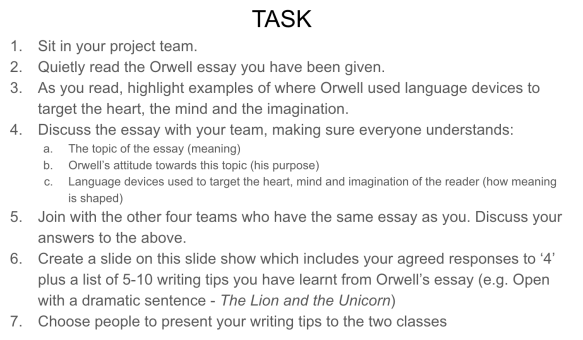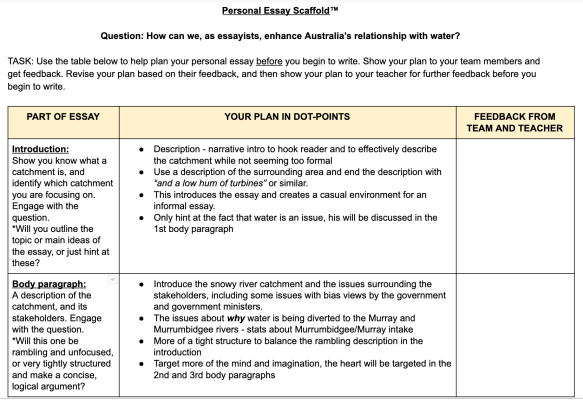This year we are embarking on transdisciplinary learning for the first time. What is transdisciplinary learning, you ask? Well, it feels like what we sometimes call cross-curricula or multi-disciplinary learning, but it’s different in its purpose. I take the term from the work happening at UTS Faculty of Transdisciplinary Innovation, after my two DPs heard the Dean of the school, Professor Louise McWhinnie, speak at a conference. You can read more about their vision here. Below is their description of what transdisciplinary learning is, and is not:
- Multi-disciplinarity occurs when the solution to a problem makes it necessary to “obtain information from two or more sciences or sectors of knowledge without the disciplines drawn on thereby being changed or enriched” (Piaget, 1972). An example is when an engineer, designer, marketeer, and UX expert come together to develop a product, using the perspectives and knowledge of each of these practices. The individual practitioners do not change or become enriched by this collaboration.
- Cross-disciplinarity is what happens when the goals and concepts of one discipline are imposed on another discipline (Jantsch, 1972). Cross-disciplinary design thinking is what happens when design is ‘imposed’ on business. Design methods such as personas, storyboarding and prototyping are used for business purposes, without adjusting these methods to the business context. Business might be enriched through this interaction (or just confused), but design does not change.
- Inter-disciplinarity is where “cooperation among various disciplines or heterogeneous sectors in the same science lead to actual interactions, to a certain reciprocity of exchanges resulting in mutual enrichment” (Piaget, 1972). For example, methods and concepts from biology, chemistry and psychology are integrated in medicine. Biology and chemistry, and psychology ‘enrich’ each other for the shared purpose of medicine. Similarly, design and computer science have enriched each other in the interdisciplinary field of interaction design.
- Transdisciplinarity takes this integration of disciplines a step further. It is a holistic approach. It is not just about interactions between specialised fields, but about placing these interactions in a total system with a social purpose. (The italics and red added by me.)
What I really like about this type of approach to learning is the ‘social purpose’ which is reinforced in the Faculty’s further observation regarding some of the pressing issues we are facing, and how working together towards solutions to these is becoming an imperative: In this rapidly changing, hyper-connected world, we are facing increasingly complex and dynamic problems. To name just a few, we are facing mass-migration, youth radicalisation, mental health problems caused by social media pressure and increasing work pressure, and climate change is getting so out of hand that we have started to enter the anthropocene.
OK, so back to the small way in which I am trying to introduce more transdisciplinary learning experiences for the gifted and talented learners at my school. This year we have introduced Praxis into year 8 – just for term one. Instead of it being what I call ‘curriculum complementary’ like year 7 Praxis (no syllabus outcomes assessed, just ‘soft skills’), it is what I call ‘curriculum aligned’ – that means that syllabus outcomes are assessed as the projects are embedded into the scope and sequences of participating subjects. This year we have designed a Geography + English project (which is the focus of this post) and a Mathematics + Science project (which I can write about later if anyone is interested). In terms of logistics, we have played around with the timetable a tiny bit to ensure that once per fortnight (we are an A and B week timetable) we have a double period that is Geo then English, or Science then Maths. We call this our Praxis session where two classes of 30 work with their teachers (plus me, the Praxis teacher) in a purposefully designed space (thanks P&C!). During this time students actively apply their learning through project work – the old campfire, waterhole, cave set-up is being used to structure this double period. All work that happens in the classroom during ‘traditional’ lessons is directly related to the project, which means when we get to the Praxis sessions students are raring to go!
So, the current English + Geography (Geolish, lulz) project can be seen on the project outline below:

So, as you can see, the social problem that students are addressing is Australia’s relationship with water, specifically with freshwater. Students are learning all about the management of catchments in NSW in Geography, and they are demonstrating this through the form of a personal essay (which they are learning all about in English!). In my English class (yes, I get to be the English teacher AND the Praxis teacher for this project), we have been studying the wonderful writing of Tim Winton – looking mostly at his non-fiction, but also some fiction in the form of extracts from novels and short stories. Winton is SUCH a great mentor for young writers, and the fact that he always writes about water is an added bonus! From Winton students have learnt about how to create an engaging piece of writing that is persuasive, emotive, imaginative and informative. They have also considered how he uses the essay form to represent the different relationships that Australians have with water – economic, aesthetic, cultural and spiritual.
Last we we turned our attention specifically to the personal essay form, and who better to be my students’ guide than my favourite author, George Orwell? I ran a session on the personal essay for with the two year 8 classes currently doing the project. We started with me delivering a presentation on the language features and structure of the personal essay. (Click Personal Essays to download a PDF of the presentation.)
 Following this, we allocated each project team one of four essays written by Orwell – Some Thoughts on the Common Toad, In Defence of British Cookery, Good Bad Books, and the first part of The Lion and the Unicorn. Students complete these tasks as shown below… and you can see their ‘Tips from Orwell’ underneath the task – they did really well, and told me the were very confident with the form now. Many also enjoyed Orwell’s voice, and indicated that they wanted to read more of his writing – winning!
Following this, we allocated each project team one of four essays written by Orwell – Some Thoughts on the Common Toad, In Defence of British Cookery, Good Bad Books, and the first part of The Lion and the Unicorn. Students complete these tasks as shown below… and you can see their ‘Tips from Orwell’ underneath the task – they did really well, and told me the were very confident with the form now. Many also enjoyed Orwell’s voice, and indicated that they wanted to read more of his writing – winning!

After this single period lesson, we had out Praxis double period. I started off the double explaining to them the importance of planning their essay, and gave them a template to use as a planner. I had collaborated with my Geography colleague (who also has my class) via Google docs to create the planner, making sure that it included by Geography and English elements. I absolutely love how this document turned out, and the students’ responses to it has shown me that it is not just another ‘thing’ I’ve made them do, they are actually filling it in really thoughtfully and have commented on how it makes the final product much more achievable. Here is an example of two students using it for their essays – I just love that they are both clearly thinking about their purpose before they writes, so powerful for young writers to know they have the capacity to affect their readers through the language features they use!

Anyway, I haven’t seen my class since last Friday (I was off sick the last two days), so it has been nice to see via Google docs that they are using the planners. After they have completed the planner, they will fill in their personal medals and missions at the bottom… see below:

Once this is done, they will seek feedback from their two team-members, fix up suggestions, and then it will come to me for feedback. Students must read through their feedback and identify three goals to work on as they write their personal essay. This process seems long-winded, but it is essential in ensuring they become self-directed learners who have the capacity to reflect on their strengths and weaknesses in order to improve. I’m really looking forward to reading their final responses, which is pretty weird, but they will all be so unique and given I have seen where they have started as writers, I’m eager to see where they end up! At this point, I can say that all the hard work and planning to get this first transdisciplinary project off the ground has absolutely been worth it.




You are amazing Bianca. I am always in awe of your creativity. Thank you for sharing it with us!
Hello Emily! Thank you for saying this! I’ve been a bit slack on the blogging since I became HT in 2015, but I’m taking a break from Twitter so this will now be my place to share… possible not always creative ideas, likely ranty stuff too. Thanks for reading and commenting, it motivates me to keep writing and sharing! ❤
This is the dream. We are implementing a transdisciplinary approach for 7-9 commencing in 2020. Would love to hear about the Math Science approach also.
I will write it up in a few weeks once the project is complete – pretty fun, doesn’t have a public audience which is a bummer, but is very hands-on and engaging for the students nonetheless.
I often find myself getting trapped in the thinking that PBL needs to be ‘hands-on practical’, what you capture here Bianca is the ability to take ‘personal’ action by finding voice. Thank you for sharing.
Also on: Read Write Collect
Hey Aaron… for me PBL is not so much ‘hands-on’ as it is ‘authentic’. I am an English teacher, so ‘hands-on’ in a practical way doesn’t necessarily reflect the authentic work done by people working in my discipline. I think this goes for geography to an extent as well, geographers spend a lot of their time writing and communicating their findings to a public audience. That’s what this project is about. 🙂
I love the way you are so consciously focused on “knowledge rich” curriculum elements in this process. A “curriculum aligned” PBL makes so much sense to me. Please do write up the Maths/Science project when you get time 🙂
A question: In the “Discover/Create/Share” framework, approximately what share of time is spent on each phase? Is this time allocation planned out, or do students adjust as required?
It depends on the nature of the project, typically the ‘discover’ is the longer stage, then the ‘create’ and then the ‘share’. That really does depend on what the project is about, what students are expected to produce, the nature of your students etc.
There is always a step in PBL where you co-create a class calendar to help plan how long they might need to spend on each stage, and try to break down loosely what each stage requires.